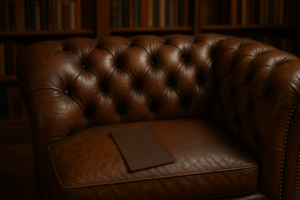Chesterfield Wiki
Official wiki of Chesterfield information
Investing in a Chesterfield sofa is a commitment to timeless style and enduring quality. However, the market is flooded with both genuine leather and high-quality faux alternatives, making it crucial to know how to spot the difference. This guide provides you with the essential, actionable tests to confidently identify a genuine leather Chesterfield versus a faux one, ensuring your investment is authentic and built to last.
Contents
The Sensory Test: Feel and Smell
The first and most immediate way to distinguish real leather from faux is through touch and smell. Genuine leather is a natural material with a unique, rich, and often earthy aroma that synthetic materials cannot replicate perfectly. Faux leather will often have a chemical or plastic-like smell. To the touch, real leather is supple, cool, and slightly irregular. It has a soft, textured grain that varies across the hide. In contrast, faux leather feels consistently uniform, warmer, and can have a plasticky or overly smooth texture.
- Tip: Run your hand across the surface. Genuine leather should feel soft and develop a patina over time, while faux leather may feel sticky or cold.
- Example: Press gently into the leather. Real leather will often show slight wrinkling or creasing around the pressure point, much like human skin.
The Visual Inspection: Look Closely
Examine the surface under good light. Authentic leather is a natural product, so it is never perfect. Look for natural markings such as small scars, insect bites, or variations in the pore structure and grain pattern. These imperfections are a sign of quality and authenticity. Faux leather, being man-made, will have a perfectly consistent, repeating pattern. Its “pores” are stamped on and will look identical across the entire piece.
- Tip: Pay close attention to the backside of the material if visible. Genuine leather will have a rough, suede-like backing, whereas faux leather will have a fabric or knit backing.
- Example: Check the edges of the cushions and arms. Real leather edges are typically unfinished and rough, while faux leather edges are often folded and neatly stitched or have a perfectly clean, synthetic edge.
The Water Absorption Test: A Drop Tells All
This simple, non-destructive test is highly effective. Place a single drop of water on an inconspicuous area of the sofa. Genuine leather is porous and will absorb the water within a few seconds, darkening the spot slightly as it soaks in. Faux leather, being non-porous, will not absorb the water. The droplet will simply sit on the surface, and you will be able to wipe it away completely without a trace.
- Tip: Always ask for permission from the seller before performing this test. A reputable dealer selling genuine leather will not object.
- Example: If the water beads up and remains on the surface like on a waxed car, you are almost certainly looking at a synthetic material.
Check Documentation and Price Tags
Finally, let logic and documentation guide you. A genuine, high-quality leather Chesterfield sofa is a significant investment. If the price seems too good to be true, it probably is. Always ask for documentation. Reputable manufacturers will provide detailed information about the type of leather used (e.g., full-grain, top-grain). Labels that use vague terms like “man-made leather,” “leather-like,” or “PU leather” are clear indicators of a faux product.
- Tip: Look for tags that specify “100% Genuine Leather” or mention the specific hide, such as “Aniline Dyed Leather.”
- Example: Be wary of sellers who are evasive about the materials. A trustworthy seller will be transparent and proud to detail the authentic components of their furniture.
Conclusion
Identifying a genuine leather Chesterfield requires a multi-sensory approach. By combining the feel, smell, visual inspection, and a simple water test, you can shop with confidence. Remember that genuine leather offers unparalleled durability and a beautiful, evolving patina, making it a worthwhile heirloom piece.
- Trust your senses: the smell and unique texture of real leather are hard to fake.
- Embrace imperfections: a consistent pattern is a red flag for faux.
- Use the water test for a quick and reliable verification.
- Always scrutinize product labels and seller documentation.
- Consider the price; authentic leather is a premium product.
- Buy from reputable dealers who specialize in quality craftsmanship.
Read more at https://chesterfielddeals.com/category/chesterfield/how-do-i-identify-a-genuine-leather-chesterfield-vs-a-faux-one/
The Ultimate Guide to Chesterfield Sofa Styles
Leather Types Explained: Aniline, Semi-Aniline, and Corrected Grain
How to Measure Your Space for the Perfect Chesterfield Sofa
Hoe herken ik een echte leren Chesterfield? (External – Chesterfield Blog)
Waar op letten bij aankoop Chesterfield bank (External – House of Chesterfield)

